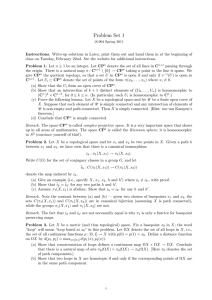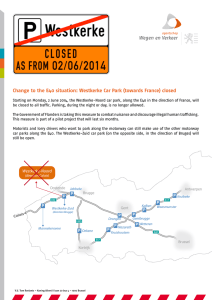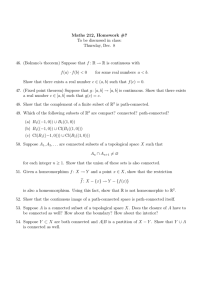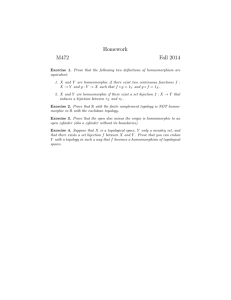Solutions to Problem Set 1
advertisement
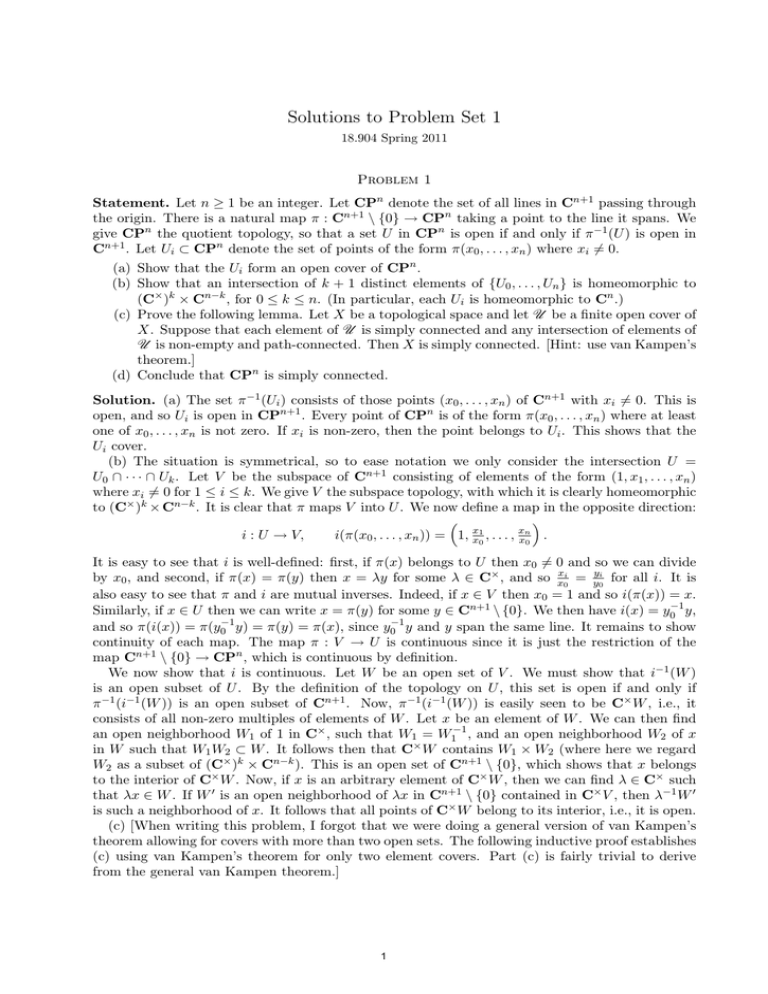
Solutions to Problem Set 1
18.904 Spring 2011
Problem 1
Statement. Let n ≥ 1 be an integer. Let CPn denote the set of all lines in Cn+1 passing through
the origin. There is a natural map π : Cn+1 \ {0} → CPn taking a point to the line it spans. We
give CPn the quotient topology, so that a set U in CPn is open if and only if π −1 (U ) is open in
Cn+1 . Let Ui ⊂ CPn denote the set of points of the form π(x0 , . . . , xn ) where xi 6= 0.
(a) Show that the Ui form an open cover of CPn .
(b) Show that an intersection of k + 1 distinct elements of {U0 , . . . , Un } is homeomorphic to
(C× )k × Cn−k , for 0 ≤ k ≤ n. (In particular, each Ui is homeomorphic to Cn .)
(c) Prove the following lemma. Let X be a topological space and let U be a finite open cover of
X. Suppose that each element of U is simply connected and any intersection of elements of
U is non-empty and path-connected. Then X is simply connected. [Hint: use van Kampen’s
theorem.]
(d) Conclude that CPn is simply connected.
Solution. (a) The set π −1 (Ui ) consists of those points (x0 , . . . , xn ) of Cn+1 with xi 6= 0. This is
open, and so Ui is open in CPn+1 . Every point of CPn is of the form π(x0 , . . . , xn ) where at least
one of x0 , . . . , xn is not zero. If xi is non-zero, then the point belongs to Ui . This shows that the
Ui cover.
(b) The situation is symmetrical, so to ease notation we only consider the intersection U =
U0 ∩ · · · ∩ Uk . Let V be the subspace of Cn+1 consisting of elements of the form (1, x1 , . . . , xn )
where xi =
6 0 for 1 ≤ i ≤ k. We give V the subspace topology, with which it is clearly homeomorphic
to (C× )k × Cn−k . It is clear that π maps V into U . We now define a map in the opposite direction:
i : U → V,
i(π(x0 , . . . , xn )) = 1, xx10 , . . . , xxn0 .
6 0 and so we can divide
It is easy to see that i is well-defined: first, if π(x) belongs to U then x0 =
×
by x0 , and second, if π(x) = π(y) then x = λy for some λ ∈ C , and so xx0i = yy0i for all i. It is
also easy to see that π and i are mutual inverses. Indeed, if x ∈ V then x0 = 1 and so i(π(x)) = x.
Similarly, if x ∈ U then we can write x = π(y) for some y ∈ Cn+1 \ {0}. We then have i(x) = y0−1 y,
and so π(i(x)) = π(y0−1 y) = π(y) = π(x), since y0−1 y and y span the same line. It remains to show
continuity of each map. The map π : V → U is continuous since it is just the restriction of the
map Cn+1 \ {0} → CPn , which is continuous by definition.
We now show that i is continuous. Let W be an open set of V . We must show that i−1 (W )
is an open subset of U . By the definition of the topology on U , this set is open if and only if
π −1 (i−1 (W )) is an open subset of Cn+1 . Now, π −1 (i−1 (W )) is easily seen to be C× W , i.e., it
consists of all non-zero multiples of elements of W . Let x be an element of W . We can then find
an open neighborhood W1 of 1 in C× , such that W1 = W1−1 , and an open neighborhood W2 of x
in W such that W1 W2 ⊂ W . It follows then that C× W contains W1 × W2 (where here we regard
W2 as a subset of (C× )k × Cn−k ). This is an open set of Cn+1 \ {0}, which shows that x belongs
to the interior of C× W . Now, if x is an arbitrary element of C× W , then we can find λ ∈ C× such
that λx ∈ W . If W 0 is an open neighborhood of λx in Cn+1 \ {0} contained in C× V , then λ−1 W 0
is such a neighborhood of x. It follows that all points of C× W belong to its interior, i.e., it is open.
(c) [When writing this problem, I forgot that we were doing a general version of van Kampen’s
theorem allowing for covers with more than two open sets. The following inductive proof establishes
(c) using van Kampen’s theorem for only two element covers. Part (c) is fairly trivial to derive
from the general van Kampen theorem.]
1
We proceed by induction on the cardinality of U . It is clear if #U = 1. Now let U =
{U1 , . . . , Un } be given. Put Y = U2 ∪U3 ∪· · ·∪Un . By the inductive hypothesis applied to Y and the
cover {U2 , . . . , Un }, we conclude that Y is simply connected. Now, U1 ∩Y = (U1 ∩U2 )∪· · ·∪(U1 ∩Un ).
We claim that this set is path connected. Thus let x and y be points in it. Then x belongs to
U1 ∩ Ui and y belongs to U1 ∩ Uj , for some i and j. The sets U1 ∩ Ui and U1 ∩ Uj are non-empty,
path-connected, contained in Y and each contain the non-empty U1 ∩ Ui ∩ Uj . It follows that we
can find a path in U1 ∩ Ui from x to some point in U1 ∩ Ui ∩ Uj , and then a path in U1 ∩ Uj from
this point to y. The composite path provides a path from x to y contained entirely in U1 ∩ Y . This
proves that U1 ∩ Y is path connected. Now, U1 and Y are simply connected and their intersection
is path-connected; van Kampen’s theorem now shows that X = U1 ∪ Y is simply connected. This
completes the proof.
(d) The open cover {U0 , . . . , Un } of CPn satisfies the hypotheses of the lemma from (c), and so
CPn is simply connected.
Problem 2
Statement. Let X be a topological space and let x1 and x2 be two points in X. Given a path h
between x1 and x2 , we have seen that there is a canonical isomorphism
ih : π1 (X, x1 ) → π1 (X, x2 ).
Write C(G) for the set of conjugacy classes in a group G, and let
ih : C(π1 (X, x1 )) → C(π1 (X, x2 ))
denote the map induced by ih .
(a) Give an example (i.e., specify X, x1 , x2 , h and h0 ) where ih 6= ih0 , with proof.
(b) Show that ih = ih0 for any two paths h and h0 .
(c) Assume π1 (X, x1 ) is abelian. Show that ih = ih0 for any h and h0 .
Solution. (a) Take X to be S 1 ∨ S 1 , take x1 = x2 to be the point where the two circles meet,
take h to be the trival path from x1 to itself and take h0 to be the path going around one of
the circles. Then ih is the identity map from π1 (X, x1 ) to itself, while ih0 is given by conjugation
by [h0 ], regarded as an element of π1 (X, x1 ). Since the center of π1 (X, x1 ) is trivial (we know
this fundamental group is the free group on two letters) and [h0 ] is non-trivial (it is one of the
generators), conjugation by [h0 ] is not the identity map on π1 (X, x1 ). Thus ih 6= ih0 .
(b) If g is an element of π1 (X, x1 ) then ih (g) is by definition h−1 gh, where h−1 is the reverse
path from x2 to x1 , and juxtaposition denotes concatenation of paths. We thus have
ih0 (g) = (h0 )−1 gh0 = (h0 )−1 hih (g)h−1 h0 = aih (g)a−1 ,
where a = (h0 )−1 h is an element of π1 (X, x2 ). This shows that ih0 (g) and ih (g) are conjugate in
π1 (X, x2 ). Thus ih0 = ih .
(c) In an abelian group, two elements are conjugate if and only if they are equal. Thus ih = ih0
implies ih = ih0 .
Problem 3
Statement. Let X be a metric (and thus topological) space. Fix a basepoint x0 in X; the word
“loop” will mean “loop based at x0 ” in this problem. Let ΩX denote the set of all loops in X, i.e.,
the set of all continuous functions p : [0, 1] → X with p(0) = p(1) = x0 . Define a distance function
on ΩX by d(p1 , p2 ) = maxx∈[0,1] d(p1 (x), p2 (x)).
(a) Show that concatentation of loops defines a continuous map ΩX × ΩX → ΩX. Conclude
that there is a natural map of sets π0 (ΩX) × π0 (ΩX) → π0 (ΩX). [Here π0 denotes the set
of path components.]
2
(b) Show that two loops in X are homotopic if and only if the corresponding points of ΩX are
in the same path component.
(c) Construct a canonical bijection of sets π0 (ΩX) → π1 (X, x0 ). Show that this map is a
homorphism, in the sense that it respects the multiplications on the two sets (the one on
π0 (ΩX) constructed in (a) and the usual group operation on π1 (X, x0 )).
Solution. (a) Let (p1 , p2 ) be an element of ΩX × ΩX and let > 0 be given. If (p01 , p02 ) is another
point of ΩX × ΩX such that d(p1 , p01 ) < and d(p2 , p02 ) < , then d(p1 p2 , p01 p02 ) < as well; this
is immediate from the definitions. By elementary properties of metric spaces, this implies that
concatenation of loops is continuous. We now have maps
π0 (ΩX) × π0 (ΩX) → π0 (ΩX × ΩX) → π0 (ΩX),
where the first comes from basic point-set topology, and the second is the one induced from the
concatenation map.
(b) Let p0 and p1 be two loops in X. Suppose first that they are homotopic. Let pt be a homotopy
between them. Then t 7→ pt provides a path between p0 and p1 in ΩX, provided it is continuous.
We now show that it is continuous. Let t ∈ [0, 1] and > 0 be given. Since (t, x) 7→ pt (x) is
continuous, for each x ∈ [0, 1] we can find an open rectangle Ux in [0, 1]2 containing (t, x) with
the property that d(pt1 (x1 ), pt2 (x2 )) < for all (t1 , x1 ) and (t2 , x2 ) in Ux . By compactness of the
interval, we can find x1 , . . . , xn such that Ux1 , . . . , Uxn covers t × [0, 1]. The union of these open
sets contains a rectangle of the form V × [0, 1], where V is an open interval containing t. Thus for
any t0 ∈ V we have d(pt , pt0 ) < . This shows that t 7→ pt is continuous.
Now suppose that p0 and p1 belong to the same path component of ΩX. Let P : [0, 1] → ΩX be a
path connecting them, i.e., a continuous map with P (0) = p0 and P (1) = p1 . Let e : [0, 1]×ΩX → X
be the evaluation map (x, p) 7→ p(x). Define a map [0, 1]2 → X by (t, x) 7→ e(x, P (t)). This is a
homotopy between p0 and p1 , provided it is continuous. To show that it is continuous, it suffices
to show that e is continuous.
We now do this. Let (x, p) ∈ [0, 1] × ΩX and > 0 be given. Let J be an open neighborhood of
x such that d(p(x1 ), p(x2 )) < for all x1 , x2 ∈ J. Let U be the open ball in ΩX centered at p and
of radius . If (x1 , p1 ) belongs to J × ΩX then
d(p(x), p1 (x1 )) ≤ d(p(x), p(x1 )) + d(p(x1 ), p1 (x1 )) ≤ 2.
This shows that e is continuous.
(c) Define a map i : π0 (ΩX) → π1 (X, x0 ) as follows. Let C be a path component of ΩX and let
p be a point on C. Then i(C) is the class of p in π1 (X, x0 ). This is well-defined by (b): if p0 is a
different point on C, then there is a path between p and p0 in ΩX and thus a homotopy between
p and p0 in X, and so p and p0 represent the same class in π1 (X, x0 ). It is also injective by (b). It
is obviously surjective. Furthermore, it is obviously compatible with the two product operations,
since they’re both defined by concatenation.
Problem 4
Statement. In this problem, we will show that every finitely presented group occurs as a fundamental group.
(a) Let G be a group, let a be an element of G and let N be the normal closure of the subgroup
generated by a. [Explicitly, N is the subgroup of G generated by all conjugates of a.] Let
Z → G be the map defined by 1 7→ a. Show that the amalgamated free product G ∗Z 1 is
isomorphic to G/N . [Here 1 denotes the trivial group.]
(b) Let X be a topological space with base point x0 and let i : S 1 → X be a loop based at x0 .
Let X 0 be the topological space obtained by attaching a 2-disc to X via i; that is, X 0 is the
quotient of X q D2 where an element x ∈ S 1 = ∂D2 is identified with i(x) ∈ X. Show that
3
π1 (X 0 , x0 ) is the quotient of π1 (X, x0 ) by the normal subgroup generated by the class of i.
[Hint: use van Kampen’s theorem.]
(c) Show that every finitely presented group occurs as a fundamental groups. [Hint: let G be a
finitely presented group. Pick a presentation. Start with a bouquet of circles, one for each
generator. Attach a 2-disc for each relation and apply (b).]
Solution. (a) It’s easiest to prove this using the universal property of amalgamated free products.
Let H be an arbitrary group. Giving a map G ∗Z 1 → H is the same as giving a map G → H that
kills a, and this is the same as giving a map G/N → H. This shows that G/N satisfies the same
universal property as G ∗Z 1, and so the two are isomorphic.
(b) We first remark that it suffices to treat the case where X is path-connected. Indeed, let X1
be the path component to which x0 belongs and let X10 be constructed in an analogous manner to
X 0 . We have a diagram
/ π1 (X 0 , x0 )
π1 (X, x0 )
O
O
π1 (X1 , x0 )
/ π1 (X 0 , x0 )
1
The diagram obviously commutes. The vertical maps are easily seen to be isomorphisms, since π1
only depends on the path component that the basepoint lies in. We thus see that if the bottom
map is surjective with kernel the normal closure of [i], then the top map has the same property.
Thus we may as well replace X by X1 and assume that X is path-connected.
Let 0 be a chosen point on D2 not on its boundary. Let U = X 0 \ {0} and let V be the open
unit disc, regarded as a subset of X 0 . Let x1 be a point in U ∩ V and let h be a path from x0 to
x1 such that h(t) ∈ U ∩ V for t 6= 0. We have a commutative diagram
π1 (U, x1 )
O
/ π1 (X 0 , x1 )
O
π1 (U, x0 )
/ π1 (X 0 , x0 )
where the horizontal maps are the natural ones and the vertical ones are ih . Furthermore, the
natural map π1 (X, x0 ) → π1 (U, x0 ) is an isomorphism, since U deformation retracts onto X. It
follows that π1 (X, x0 ) → π1 (X 0 , x0 ) is a surjection with kernel the normal closure of the subgroup
generated by [i] if and only if π1 (U, x1 ) → π1 (X 0 , x1 ) is a surjection with kernel the normal closure
of the subgroup generated by j = ih ([i]). (Sorry for the two i’s!)
Now, U and V are path-connected open sets that cover X 0 and their intersection is path connected
and contains x1 . In fact, their intersection is an annulus and j generates its fundamental group.
By van Kampen’s theorem, π1 (X 0 , x1 ) = π1 (U, x1 ) ∗Z 1, where Z is really π1 (U ∩ V, x1 ) and 1 is
really π1 (V, x1 ). Since the map Z → π1 (U, x1 ) sends 1 to j, we see from part (a) that π1 (X 0 , x1 ) is
the quotient of π1 (U, x1 ) by the normal subgroup generated by j. This completes the proof of (b).
(c) Let G be a finitely generated group. Let a1 , . . . , an be generators for G and let b1 , . . . , bm
be sufficient relations to present G. Let G0 be the free group on the ai and let Gi be the quotient
of G0 by the normal subgroup generated by b1 , . . . , bi . Note that Gi is the quotient of Gi−1 by
the normal subgroup generated by bi and that Gm = G. We now prove inductively that there are
spaces
X0 → X1 → · · · → Xm
such that π1 (Xi ) = Gi , and the map π1 (Xi ) → π1 (Xi+1 ) is the natural quotient map Gi → Gi+1 . To
obtain X0 , simply take a bouquet of circles, one for each ai . Assume now that we have constructed
Xi−1 . Via the map G0 → Gi−1 , we can regard bi as an element of π1 (Xi−1 ). By (b), we can now
attach a 2-disc to Xi−1 to obtain a space Xi with π1 (Xi ) = Gi . This completes the proof.
4
Problem 5
Statement. Let G be a topological group; thus G is simulateneously a group and a topological
space, and the multiplication map G × G → G and inversion map G → G are continuous.
(a) Show that there is a unique group structure on π0 (G) such that the natural map G → π0 (G)
is a group homomorphism.
(b) Show that π1 (G, 1) is a commutative group. [Hint: if c is a loop in G based at 1 and g is
an element of G then t 7→ gc(t) is a loop in G based at g. Using this you can slide one loop
along another to show that they commute in π1 .]
Solution. (a) The map G → π0 (G) is surjective, so there is at most one group structure on
π0 (G) which makes this map a homomorphism. Let G◦ be the path component of G containing
the identity element. Then G◦ is a normal subgroup of G. Indeed, suppose that x and y belong to
G◦ . Let p be a path from 1 to x and let q by a path from 1 to y. Then t 7→ xq(t) is a path from
x to xy. Concatenating this with p, we obtain a path from 1 to xy. This shows that G◦ is closed
under multiplication. It is clear that G◦ is closed under inversion; t 7→ p(t)−1 provides a path from
1 to x−1 . This shows that G◦ is a group. Finally, if y is any element of G then t 7→ yp(t)y −1 is a
path from 1 to yxy −1 , and so G◦ is normal.
We now claim that two elements x and y of G belong to the same path component if and only
if xy −1 ∈ G◦ . First suppose that xy −1 ∈ G◦ . Let p be a path from 1 to xy −1 . Then t 7→ p(t)y is
a path from x to y, and so x and y lie in the same path component. Conversely, suppose that p is
a path from x to y. Then t 7→ p(t)y −1 is a path from xy −1 to 1, and so xy −1 belongs to G◦ . This
establishes the claim.
It follows that the natural map G → π0 (G) factors as G → G/G◦ followed by the bijection
G/G◦ → π0 (G). Since G◦ is normal, G/G◦ is a group, and the bijection of this with π0 (G) gives a
group structure on π0 (G).
(b) Let f and g be two loops based at the identity. Let Ft be the concatenation of the following
paths: first, the path f |[0,t] , from 1 to f (t); then, the loop s 7→ f (t)g(s), based at f (t); and finally,
the map f |[t,1] from f (t) to 1. (In the second step, the juxtaposition denotes multiplication in the
group.) One easily sees that F : [0, 1]2 → G is continuous. (The function F is defined piecewise
on three regions in [0, 1]2 . It is clearly continuous on each region, and there is agreement at the
boundaries. This implies it is continuous.) Now, F (0) is the concatenation gf , while F (1) is the
concatenation f g. Thus f g and gf are homotopic, and so π1 (X, 1) is commutative.
Problem 6
Statement. Let G = SL(2, R), the group of 2 × 2 real matrices with determinant 1. We can naturally regard G as a closed subset of R4 , and thus (after a few simple verifications) as a topological
group. Let B ◦ ⊂ G be the subgroup of matrices which are upper-triangular with positive entries
on the diagonal. Let K ⊂ G be the subgroup of rotations matrices. [An element of G belongs to
K if and only if its two columns form an orthonormal basis of R2 .]
(a) Show that B ◦ is homeomorphic to R2 , and is thus contractible.
(b) Show that K is homeomorphic to S 1 .
(c) Show that the map B ◦ × K → G sending (b, k) to bk is a homeomorphism.
(d) Conclude that G is homotopy equivalent to S 1 , and thus has fundamental group Z.
Solution. (a) The group B ◦ consists of matrices of the form
a b
a−1
with a > 0. We thus have evident bijections between B ◦ and R≥0 × R sending a point (a, b)
in R≥0 × R to the above matrix, and the above matrix to (a, b) in R≥0 × R. These maps are
5
each continuous since their components are. We thus find that B ◦ is homeomorphic to R≥0 × R.
Since R≥0 is homeomorphic to R (by the logarithm and exponential maps), we find that B ◦ is
homeomorphic to R2 , and thus contractible.
(b) A rotation matrix necessarily has the form
x y
−y x
with x2 +y 2 = 1. We thus have evident bijections between K and S 1 sending a point (x, y) on S 1 to
the above matrix, and the above matrix to the point (x, y) on S 1 . These maps are each continuous
since their components are continuous functions.
(c) Let h, i be the standard inner product on R2 ; it is given by
hx, yi = x1 y1 + x2 y2 .
kxk2
Let
= hx, xi be the associated norm. Let e1 , e2 be the standard basis for R2 . Let g be an
element of G. Then ge1 and ge2 is also a basis for R2 . The Graham–Schmit process allows us to
take this basis and obtain an orthonormal basis. Precisely, put
f1 =
ge1
= A(g )ge1 ,
kge1 k
f2 =
ge2 − hge1 , ge2 ikge1 k−1 ge1
= D(g)ge2 + B(g)ge1
kge2 − hge1 , ge2 ikge1 k−1 ge1 k
(Here A(g), B(g) and D(g) are just real numbers; for instance, A(g) = kge1 k−1 .) Then f1 and f2
form an orthonormal basis for R2 . Let β(g) be defined by
A(g) B(g)
−1
β(g) =
D(g)
Then fi = gβ(g)−1 ei . Since κ(g) = gβ(g)−1 takes the orthonormal basis (e1 , e2 ) to the orthonormal
basis (f1 , f2 ), it follows that κ(g) belongs to K. Thus β(g) has determinant 1, and is clearly upper
triangular, and so belongs to B ◦ . Since the components of β(g)−1 (i.e., A, B and D) are clearly
continuous functions of G, we find that β : G → B ◦ is continuous. Since κ is defined from β and
matrix multiplication, κ : G → K is continuous.
We have thus constructed a continuous function
G → K × B◦,
g 7→ (κ(g), β(g))
which is a one-sided inverse to the (obviously) continuous function
K × B ◦ → G,
(b, k) 7→ bk,
i.e., the composite G → K × B ◦ → G is the identity. To finish the proof, it suffices to show that the
map K × B ◦ → G is injective, for then the two maps are forced to be mutual inverses. Thus assume
that bk = b0 k 0 . Then (b0 )−1 b = k 0 k −1 , and so k 0 k −1 belongs to K ∩ B ◦ . However, K ∩ B ◦ = 1 (easy
calculation), and so k = k 0 , from which it follows that b = b0 . This completes the proof.
[I just noticed that I did things backwards! The problem asked to show that B ◦ × K → G is a
homeomorphism and I showed that K × B ◦ → G is a homeomorphism. There are two ways to fix
this. First, one could change the above proof, using row operations instead of column operations.
Or, one could observe that there is a commutative diagram
GO
K × B◦
φ
/G
O
ψ
/ B◦ × K
where the vertical maps are multiplication maps, φ(g) = g −1 and ψ(k, b) = (b−1 , k −1 ). Since φ, ψ
and the left map are homeomorphisms, it follows that the right map is as well.]
6
(d) From (a)–(c), we find that G is homeomorphic to R2 × S 1 , and thus homotopy equivalent to
S 1 . Thus π1 (G) = Z.
7
MIT OpenCourseWare
http://ocw.mit.edu
18.904 Seminar in Topology
Spring 2011
For information about citing these materials or our Terms of Use, visit: http://ocw.mit.edu/terms.
